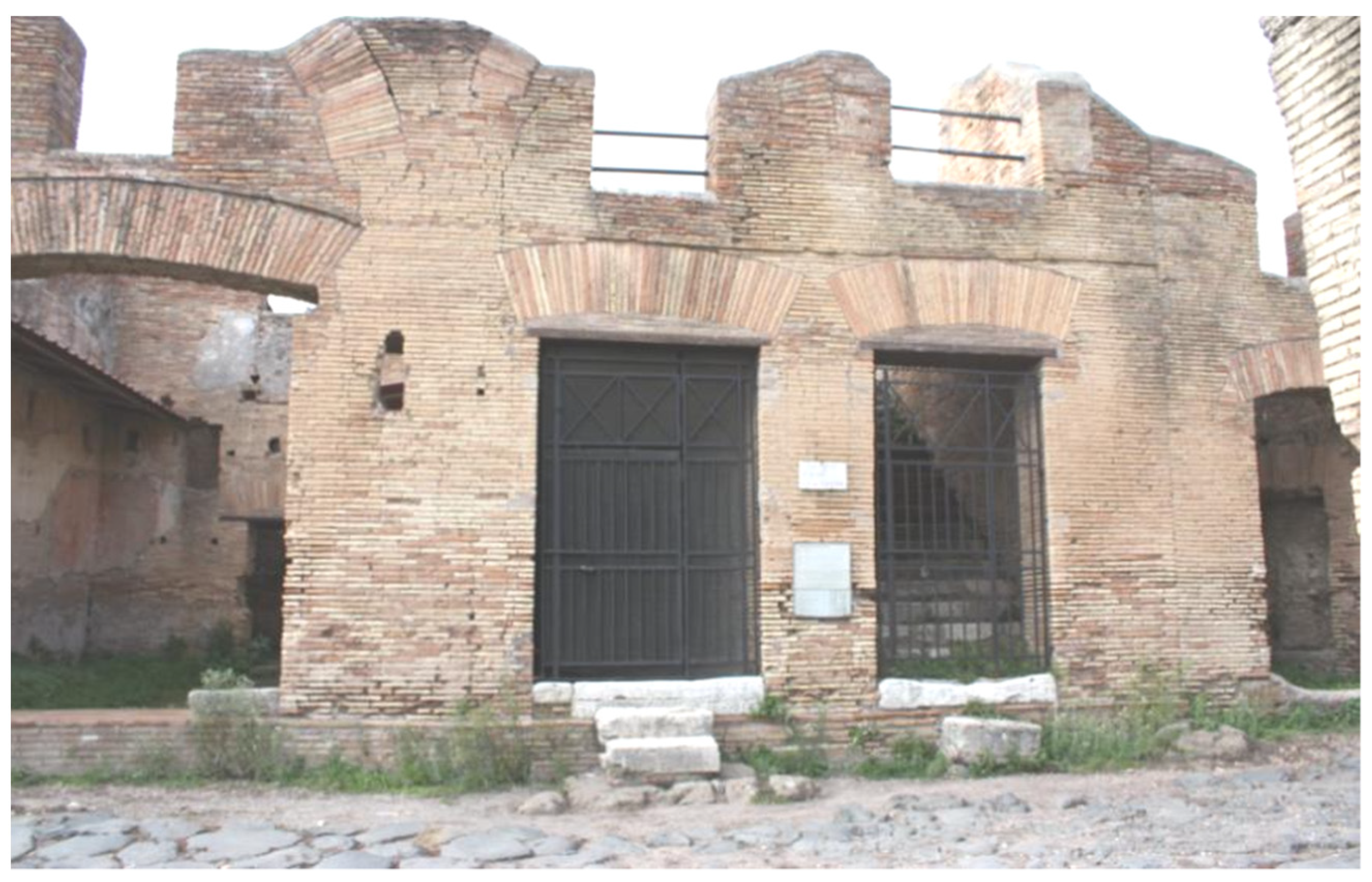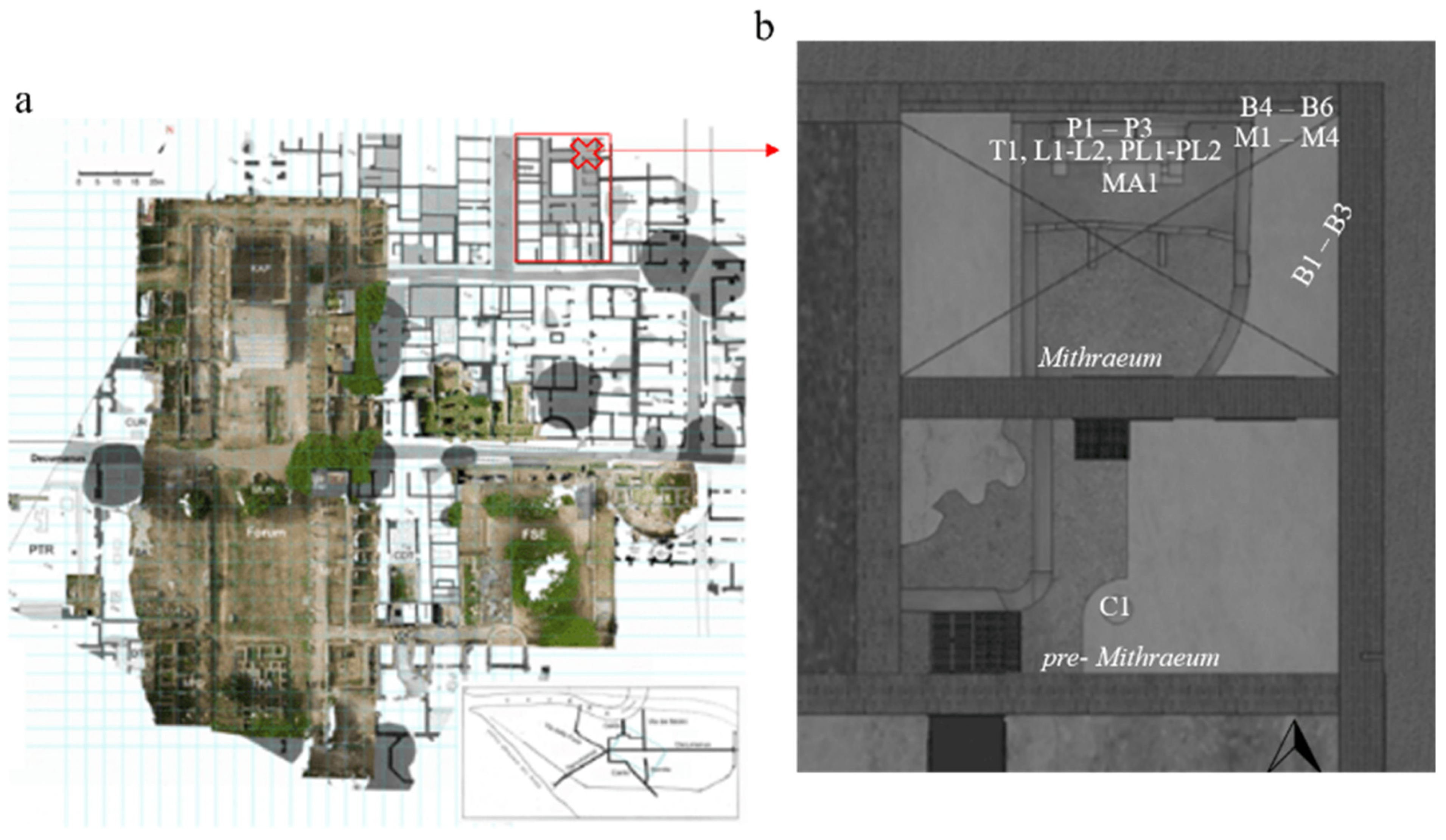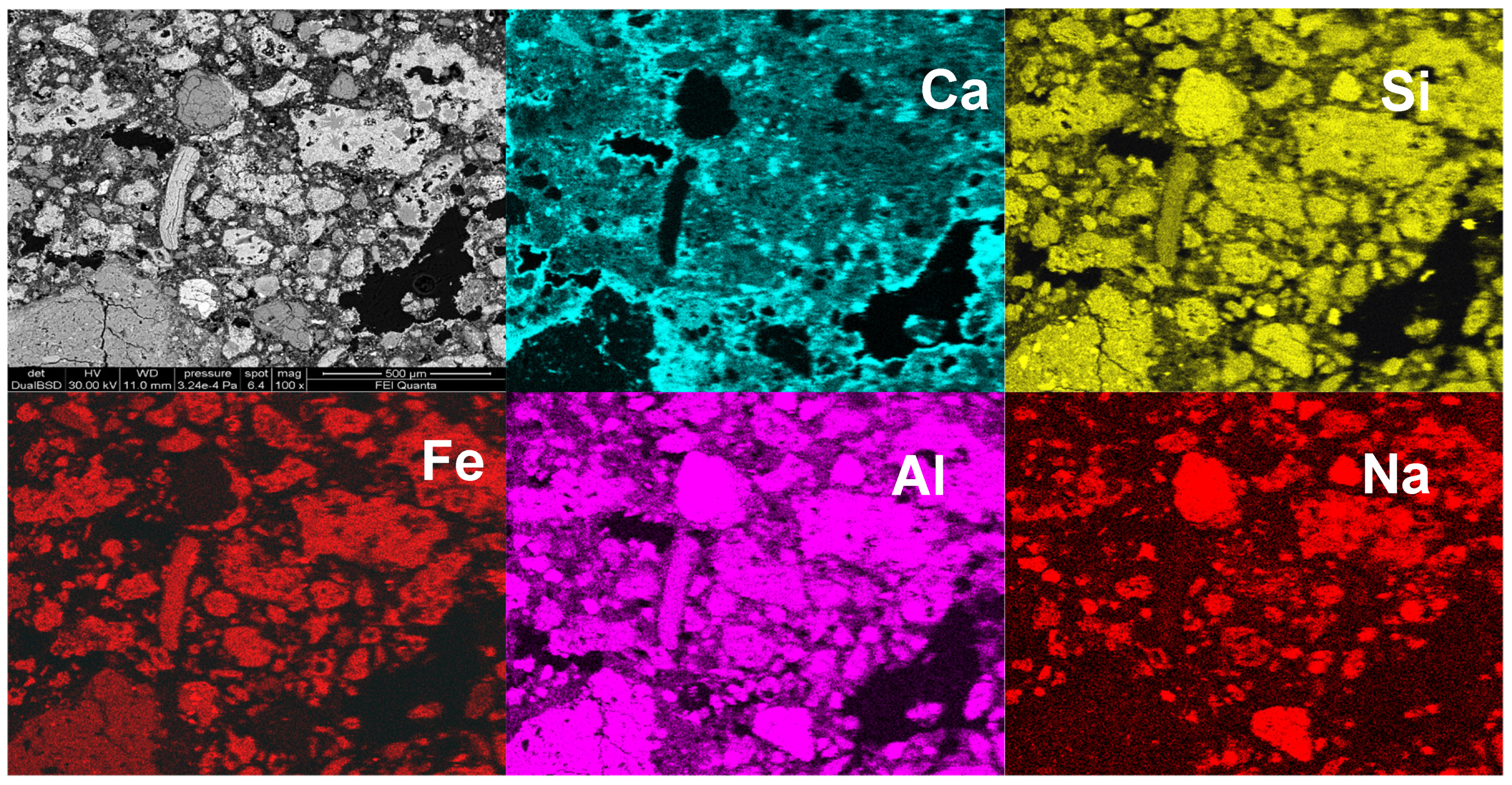Petrographic-Mineralogical Characterization of Archaeological Materials from “Casa di Diana” Mithraeum Sited in the Open Museum of Ostia Antica
Abstract
:1. Introduction
Casa di Diana Mithraeum
2. Materials and Methods
2.1. Sample’s Collection
2.2. Instrumentation and Analytical Techniques
3. Results and Discussion
3.1. Bricks
3.2. Mortars
3.3. Other Materials
4. Conclusions
Author Contributions
Funding
Institutional Review Board Statement
Informed Consent Statement
Data Availability Statement
Acknowledgments
Conflicts of Interest
References
- Laurenti, M.C. Le Coperture Delle Aree Archeologiche: Museo Aperto; Gangemi Editore SpA: Rome, Italy, 2006. [Google Scholar]
- Dey, T.; Carter, J.C.; Swift, K. SEM-EDX and FTIR analysis of archaeological ceramic potteries from southern Italy. Microscopy 2020, 69, 371–380. [Google Scholar] [CrossRef]
- Lucchi, E. Multidisciplinary risk-based analysis for supporting the decision making process on conservation, energy efficiency, and human comfort in museum buildings. J. Cult. Herit. 2016, 22, 1079–1089. [Google Scholar] [CrossRef]
- Canciani, V. Revising an archaeological context through archival excavation: The Duino Mithraeum as a case study. In Proceedings of the Humanities in the Third Millennium: Approaches, Contamination and Perspectives, Verona, Italy, 17 October 2019; Cierre Edizioni: Pescia, Italy, 2020; pp. 15–26. [Google Scholar]
- Frasca, F.; Verticchio, E.; Caratelli, A.; Bertolin, C.; Camuffo, D.; Siani, A.M. A Comprehensive Study of the Microclimate-Induced Conservation Risks in Hypogeal Sites: The Mithraeum of the Baths of Caracalla (Rome). Sensors 2020, 20, 3310. [Google Scholar] [CrossRef] [PubMed]
- Sclavi, S.; Monaco, M.; Carnevale, F.; Ranieri, M.; Gaudenzi, S.; Polcaro, F.V.; Scatigno, C. The orientation of the Mithraea in Ostia Antica. Mediterr. Archaeol. Archaeom. 2016, 16, 4. [Google Scholar]
- Sparavigna, A.C. On the Astronomical Orientation of Mithraea; Department of Applied Science and Technology, Politecnico di Torino: Turin, Italy, 2017. [Google Scholar]
- Martin, L.H. Seeing the Mithraic tauroctony. Numen 2021, 68, 357–381. [Google Scholar] [CrossRef]
- Rubio, R. Multisensory Experiences in Mithraic Initiation. In SENSORIVM: The Senses in Roman Polytheism; Brill: Leiden, The Netherlands, 2021; pp. 177–191. [Google Scholar] [CrossRef]
- Available online: https://www.ia-ostiaantica.org/news/il-caseggiato-di-diana/ (accessed on 19 July 2021).
- Scatigno, C. An Innovative Multidisciplinary Methodology to Evaluate the Conservation State of Cultural Sites as a Whole: Casa di Diana (Ostia Antica, Italy). 2017. Available online: https://addi.ehu.es/handle/10810/21565 (accessed on 19 July 2021).
- Cardarelli, E.; De Donno, G.; Oliveti, I.; Scatigno, C. Three-dimensional reconstruction of a masonry building through electrical and seismic tomography validated by biological analyses. Near Surf. Geophys. 2018, 16, 1–13. [Google Scholar] [CrossRef] [Green Version]
- Scatigno, C.; Moricca, C.; Tortolini, C.; Favero, G. The influence of environmental parameters in the biocolonization of the Mithraeum in the roman masonry of casa di Diana (Ostia Antica, Italy). Environ. Sci. Pollut. Res. 2016, 23, 13403–13412. [Google Scholar] [CrossRef]
- Scatigno, C.; Prieto-Taboada, N.; Martinez, M.P.; Conte, A.M.; Madariaga, J.M. A non-invasive spectroscopic study to evaluate both technological features and conservation state of two types of ancient Roman coloured bricks. Spectrochim. Acta Part A Mol. Biomol. Spectrosc. 2018, 204, 55–63. [Google Scholar] [CrossRef]
- Scatigno, C.; Prieto-Taboada, N.; García-Florentino, C.; de Vallejuelo, S.F.O.; Maguregui, M.; Madariaga, J.M. Combination of in situ spectroscopy and chemometric techniques to discriminate different types of Roman bricks and the influence of microclimate environment. Environ. Sci. Pollut. Res. 2018, 25, 6285–6299. [Google Scholar] [CrossRef]
- Scatigno, C.; Prieto-Taboada, N.; Festa, G.; Madariaga, J.M. Soluble Salts Quantitative Characterization and Thermodynamic Modeling on Roman Bricks to Assess the Origin of Their Formation. Molecules 2021, 26, 2866. [Google Scholar] [CrossRef] [PubMed]
- Clauss, M. The Roman Cult of Mithras: The God and His Mysteries; Routledge: London, UK, 2017. [Google Scholar]
- Scatigno, C.; Gaudenzi, S.; Sammartino, M.P.; Visco, G. A microclimate study on hypogea environments of ancient roman building. Sci. Total Environ. 2016, 566, 298–305. [Google Scholar] [CrossRef]
- Sinopoli, A.; Danila, A. The Dome of the Temple of Diana in Baiae: Opus Caementicium, Geometry and Mechanics. Int. J. Archit. Herit. 2021, 1–32. [Google Scholar] [CrossRef]
- Gering, A. Le ultime fasi della monumentalizzazione del centro di Ostia tardoantica. Attività della missione della Humboldt-Universität di Berlino tra il 2009 e il 2013. Mélanges l’École Française Rome-Antiq. 2014, 126-1. [Google Scholar] [CrossRef]
- Yaseen, I.A.B.; Al-Amoush, H.; Al-Farajat, M.; Mayyas, A. Petrography and mineralogy of Roman mortars from buildings of the ancient city of Jerash, Jordan. Constr. Build. Mater. 2013, 38, 465–471. [Google Scholar] [CrossRef]
- Aloise, P.; Ricca, M.; La Russa, M.F.; Ruffolo, S.A.; Belfiore, C.M.; Padeletti, G.; Crisci, G.M. Diagnostic analysis of stone materials from underwater excavations: The case study of the Roman archaeological site of Baia (Naples, Italy). Appl. Phys. A 2014, 114, 655–662. [Google Scholar] [CrossRef]
- Coplen, T.B. New guidelines for reporting stable hydrogen, carbon, and oxygen isotope-ratio data. Geochim. Cosmochim. Acta 1996, 60, 3359–3360. [Google Scholar] [CrossRef]
- Ray, K.W.; Mathers, F.C. Effect of Temperature and Time of Burning upon the Properties of High–Calcuim Lime1. Ind. Eng. Chem. 1928, 20, 415–419. [Google Scholar] [CrossRef]
- Robinson, H.O.; Christopher, S. Apparatus and Method for Brick-Burning. U.S. Patent No. 1,367,756, 8 February 1921. [Google Scholar]
- Pecchioni, E.; Fratini, F.; Cantisani, E. Atlas of the Ancient Mortars in Thin Section under Optical Microscope; Nardini Editore: Florence, Italy, 2014; Volume 78. [Google Scholar]
- Marra, F.; Danti, A.; Gaeta, M. The volcanic aggregate of ancient Roman mortars from the Capitoline Hill: Petrographic criteria for identification of Rome′s “pozzolans” and historical implications. J. Volcanol. Geotherm. Res. 2015, 308, 113–126. [Google Scholar] [CrossRef]
- Conte, A.M.; Corda, L.; Esposito, D.; Giorgi, E. Characterization of mortars from the medieval Abbey of Cerrate (southern Italy). J. Archaeol. Sci. Rep. 2017, 12, 463–479. [Google Scholar] [CrossRef]
- Moropoulou, A.; Bakolas, A.; Anagnostopoulou, S. Composite materials in ancient structures. Cem. Concr. Compos. 2005, 27, 295–300. [Google Scholar] [CrossRef]
- Manfra, L.; Masi, U.; Turi, B. La composizione isotopica dei travertini del Lazio. Geol. Rom. 1976, 15, 127–174. [Google Scholar]
- Minissale, A.; Kerrick, D.M.; Magro, G.; Murrell, M.T.; Paladini, M.; Rihs, S.; Vaselli, O. Geochemistry of Quaternary travertines in the region north of Rome (Italy): Structural, hydrologic and paleoclimatic implications. Earth Planet. Sci. Lett. 2002, 203, 709–728. [Google Scholar] [CrossRef]
- Attanasio, D.; Brilli, M.; Bruno, M. The properties and identification of marble from Proconnesos (Marmara Island, Turkey): A new database including isotopic, EPR and petrographic data. Archaeometry 2008, 50, 747–774. [Google Scholar] [CrossRef]
- Pavia, C. Roma Mitraica; C. Lorenzini: Pescia, Italy, 1986. [Google Scholar]
















| Scheme | Material Typology | Sampling Area | Analytical Technique |
|---|---|---|---|
| B1 | Brick | Wall Mithraeum at east side | PLM, XRD |
| B2 | Brick | Wall Mithraeum at east side | PLM, XRD |
| B3 | Brick | Wall Mithraeum at east side | PLM, XRD, SEM |
| B4 | Brick | Mithraeum on the north side. Altar (aedicule) | PLM, XRD, SEM |
| B5 | Brick | Mithraeum on the north side. Altar (aedicule) | PLM, XRD |
| B6 | Brick | Mithraeum on the north side. Altar (corbel) | PLM, XRD |
| M1 | Mortar | Wall Mithraeum on the north side | PLM, XRD, SEM |
| M2 | Mortar | Mithraeum on the north side. Altar (aedicule) | PLM, XRD, SEM |
| M3 | Mortar | Mithraeum on the north side. Altar (aedicule) | PLM, XRD, SEM |
| M4 | Mortar | Mithraeum on the north side. Altar (aedicule) | PLM, XRD, SEM |
| P1 | Pumice | Mithraeum on the north side. Altar (apse) | PLM, XRD |
| P2 | Pumice | Mithraeum on the north side. Altar (apse) | PLM, XRD |
| P3 | Pumice | Mithraeum on the north side. Altar (apse) | PLM, XRD |
| T1 | Travertine | Mithraeum on the north side. Altar (corbel) | PLM, XRD, (δ13C, δ18O) |
| L1 | Limestone | Mithraeum on the north side. Altar (block) | PLM, XRD |
| L2 | Limestone | Mithraeum on the north side. Altar (grooved block on the the base of the altar) | PLM, XRD |
| MA1 | Marble | Mithraeum on the north side. Altar support (slab resting on top of sample 20) | PLM, XRD |
| C1 | Ceramic | Dolium. pre- Mithraeum (right side inside) | PLM, XRD |
| PL1 | Plaster | Mithraeum on the north side. Altar (aedicule) | PLM, XRD |
| PL2 | Plaster | Mithraeum on the north side. Altar (apse) | PLM, XRD |
| Phases | Sample ID | |||||
|---|---|---|---|---|---|---|
| B1 | B2 | B3 ◊ | B4 | B5 | B6 | |
| Amorphous phases | + | ++ | +++ | +++ | + | + |
| Quartz | +++ | ++ | ++ | ++ | +++ | + |
| Calcite | + | ++ | +++ | + | + | - |
| Dolomite | - | - | - | - | - | + |
| Plagioclase feldspar | ++ | + | + | + | ++ | ++ |
| Pyroxene | + | Tr | - | + | - | Tr |
| Mica | - | + | + | + | Tr | + |
| Analcime | - | Tr | - | - | - | - |
| Alkaline feldspar | +++ | + | + | ++ | +++ | ++ |
| Hematite | Tr | + | - | Tr | Tr | - |
| Gypsum | - | ++ | + | - | - | - |
| Clay minerals | + | + | ||||
| Phases | Sample ID | |||
|---|---|---|---|---|
| M1 | M2 | M3 | M4 | |
| Amorphous phases | +++ | ++ | ++ | +++ |
| Quartz | Tr | Tr | - | - |
| Calcite | +++ | ++ | +++ | ++/+++ |
| Clinopyroxene | ++ | ++ | +/++ | +/++ |
| Mica | ++ | - | + | - |
| Analcime | +++ | +++ | ++ | +++ |
| Chlorite | Tr | - | - | - |
| Hematite | - | Tr | - | - |
| Phase | Sample ID | |||||||||
|---|---|---|---|---|---|---|---|---|---|---|
| P1 | P2 | P3 | T1 | L1 | L2 | MA1 | C1 | PL1 | PL2 | |
| Amorphous phases | ++ | ++ | +++ | - | - | - | - | - | - | - |
| Calcite | - | Tr | + | +++ | +++ | +++ | +++ | + | +++ | +++ |
| Quartz | - | - | - | - | - | - | - | + | - | - |
| Dolomite | - | - | - | - | - | - | Tr | - | - | - |
| Plagioclase feldspar | +++ | ++ | + | - | - | - | - | ++ | - | - |
| Augite | +++ | ++ | ++ | - | - | - | - | + | - | - |
| Mica | + | + | Tr | - | - | - | - | + | - | - |
| Analcime | Tr | - | - | - | - | - | - | - | - | - |
| Hematite | + | Tr | Tr | - | - | - | - | - | - | - |
| Alkali feldspar | - | ++ | ++ | - | - | - | - | ++ | - | - |
| Putonarite | - | - | - | - | Tr | - | - | - | - | - |
| Lanarkite | - | - | - | - | Tr | - | - | - | - | - |
| Gypsum | Tr * | Tr * | Tr * | - | - | - | - | Tr | - | - |
Publisher’s Note: MDPI stays neutral with regard to jurisdictional claims in published maps and institutional affiliations. |
© 2021 by the authors. Licensee MDPI, Basel, Switzerland. This article is an open access article distributed under the terms and conditions of the Creative Commons Attribution (CC BY) license (https://creativecommons.org/licenses/by/4.0/).
Share and Cite
Scatigno, C.; Preite Martinez, M.; Prieto-Taboada, N.; Madariaga, J.M.; Conte, A.M. Petrographic-Mineralogical Characterization of Archaeological Materials from “Casa di Diana” Mithraeum Sited in the Open Museum of Ostia Antica. Crystals 2021, 11, 839. https://doi.org/10.3390/cryst11070839
Scatigno C, Preite Martinez M, Prieto-Taboada N, Madariaga JM, Conte AM. Petrographic-Mineralogical Characterization of Archaeological Materials from “Casa di Diana” Mithraeum Sited in the Open Museum of Ostia Antica. Crystals. 2021; 11(7):839. https://doi.org/10.3390/cryst11070839
Chicago/Turabian StyleScatigno, Claudia, Maria Preite Martinez, Nagore Prieto-Taboada, Juan Manual Madariaga, and Aida Maria Conte. 2021. "Petrographic-Mineralogical Characterization of Archaeological Materials from “Casa di Diana” Mithraeum Sited in the Open Museum of Ostia Antica" Crystals 11, no. 7: 839. https://doi.org/10.3390/cryst11070839






